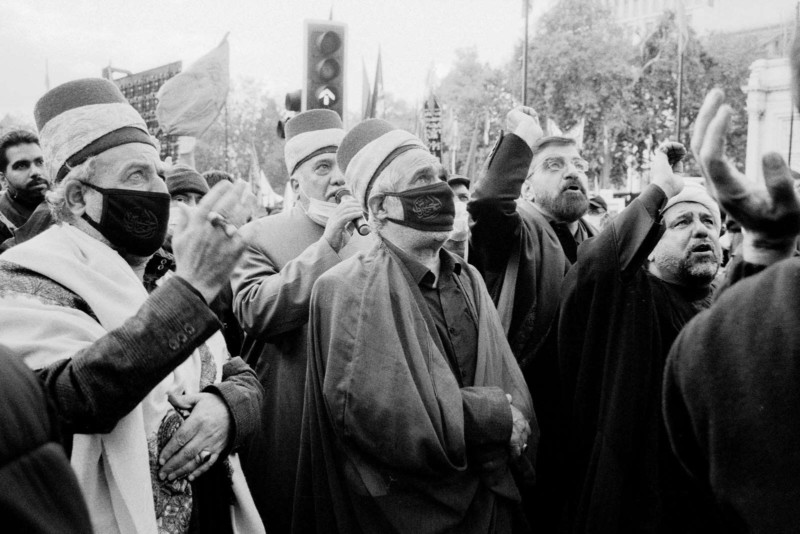When Bokeh Isn’t Best: Appreciating a Deeper Depth of Field
![]()
Recently, the more I study my photographs, the more I feel that bokeh is cheating me out of a more substantial image. I really like photographs with a lot of visual complexity — well presented, not chaotic, but a clear arrangement of multiple elements.
For example, this photograph made in 2018 with a 90mm lens at f/2 on Ilford Delta 100 film:
![]()
When I first saw this I was proud – I’d managed to isolate the key character in the center, who stands out from the crowd due to the lighter clothing and physical size. I was happy with the way he is surrounded by figures who are less clear but still part of the scene.
However, the more I look at it now the more I wish it had been taken at f/16, which would have allowed that dreamy context to be more filled with detail and life.
The potential for a complex, crowded, but still organized scene was there. That central character would still have stood out from the others; the shallow depth of field wasn’t entirely necessary for that aesthetic function. I dislike using bokeh to reduce the presence of things that I could simply work into the composition, but I now have a more active dislike of the way that it seems to have deprived me of situations that could have improved my eye.
I find that my work with 50mm and 90mm tends to be very flat, regardless of the aperture that was used. For example, this photograph from Varanasi in 2019 was also made with a 90mm, but with the benefit of experience includes a more versatile arrangement, with interest to be found in the foreground, mid-ground, and background.
![]()
Despite this, the frame is still very flat, arranged on the X and Y-axis, with little occurring on the Z. Usually this is a way I enjoy working, but to be able to create a more energetic image, I feel that I will need to explore other options — specifically wider lenses.
One of the reasons I’ve applied a more critical eye to my flatter images of late is the influence of my good friend and long-time shooting companion, David Babaian. Earlier in the summer, he switched to a 28mm lens for a majority of his work. We spent a lot of time in crowds, and his application of the wider lens to these situations just clicked. He produced some of his best work in the space of a few months, shifting him from someone whose work I respected to someone I was actually a little bit jealous of.
Working often inches from the faces of his subject, his current images invoke a very classic style — similar to that found in the work of iconic documentary photographer Abbas Attar or contemporary street photographers like Josh Edgoose. Their use of 35mm lenses and below, stopped down, and composing using foreground elements very close to the lens makes for very compelling results in my opinion.

For isolating individual characters or rendering two-dimensional scenes, a 50mm+ is ideal, but to achieve this visual depth and complexity, I am compelled to work more with a 35mm — a real challenge but one that one day will hopefully reward my efforts. One of my recent successes at this was this photograph, made on a 35mm at f/8.
![]()
The detail of the shoelace, the light coming in from the corner, all the elements are there, but one success could be a fluke. It is also a success only technically, as there is so much room for improvement. In this image and others of mine there are no visible eyes, which means little room for empathy. This needs to change.
I need to apply myself to this approach, although this has been decidedly difficult at a time when many large gatherings have been rendered effectively illegal by various pandemic restrictions.
I’m making a start by restricting myself to my rangefinders. I enjoyed the ability to work with 200mm+ on my SLRs and produced some nice images, but I really don’t see myself continuing in a direction I don’t enjoy. I know how I want my images to look, and I need to put the work into bringing my results up to the standards I enjoy in other people’s work.
Part of writing about my process, putting my internal monologue into the public eye means more pressure to follow through with moving towards my various goals. I am sure many have already gone through this process and understand how to use different lenses effectively, so would not get a lot of value from such an article.
I would hope that anyone who feels this is all obvious stuff may have something constructive to offer in the comments, as I really am open to all kinds of ideas and techniques to improve in this direction!
P.S. David and I, along with fellow photographers Andrew Blowers and Sagar Kharecha recently collaborated on publication which is currently available to purchase from our website. If you liked David’s approach as seen above and would like to see how it works in sequence alongside images made with anything from 24mm – 300mm, consider checking this zine out!
About the author: Simon King is a London based photographer and photojournalist, currently working on a number of long-term documentary and street photography projects. The opinions expressed in this article are solely those of the author. You can follow his work on Instagram. Simon also teaches a short course in Street Photography at UAL, which can be read about here.